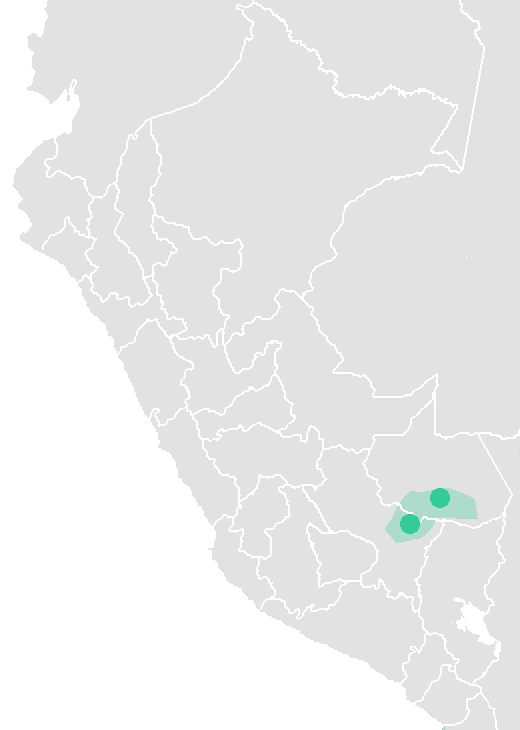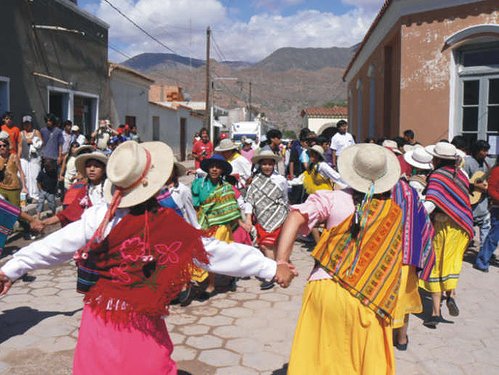|
Eshuva
The Eshuva are the Harákmbut-language sung prayers of Peru's Huachipaire people. They are sung as an expression of Huachipaire religious myths to summon nature spirits, to help alleviate illness or promote well-being, as part of traditional ceremonies, and during the initiation of the new Eshuva singers. Eshuva songs are performed without musical accompaniment. Since they are sung only in the Harákmbut language, they help safeguard the Huachipaire people's language, values, and worldview. Eshuva songs and their function – the ailment they are meant to heal – are transmitted orally. There exist only 12 known singers at present and, as transmission has been interrupted due to the Huachipaire youth's lack of interest, internal migration, and the influence and assimilation of external cultural elements, the songs are at risk of being lost. UNESCO The United Nations Educational, Scientific and Cultural Organization (UNESCO ) is a List of specialized agencies of the Unite ... [...More Info...] [...Related Items...] OR: [Wikipedia] [Google] [Baidu] |
Intangible Cultural Heritage In Need Of Urgent Safeguarding
UNESCO established its Lists of Intangible Cultural Heritage with the aim of ensuring better protection of important intangible cultural heritages worldwide and the awareness of their significance.Compare: This list is published by the Intergovernmental Committee for the Safeguarding of Intangible Cultural Heritage, the members of which are elected by State Parties meeting in a General Assembly. Through a compendium of the different oral and intangible treasures of humankind worldwide, the programme aims to draw attention to the importance of safeguarding intangible heritage, which UNESCO has identified as an essential component and as a repository of cultural diversity and of creative expression. The list was established in 2008 when the 2003 Convention for the Safeguarding of the Intangible Cultural Heritage took effect. , the programme compiles three lists. The longer Representative List of the Intangible Cultural Heritage of Humanity comprises cultural "practices and express ... [...More Info...] [...Related Items...] OR: [Wikipedia] [Google] [Baidu] |
Music Of Peru
Peruvian music is an amalgamation of sounds and styles drawing on Peru's Andean music, Andean, Music of Spain, Spanish, and Music of Africa, African roots. Andean influences can perhaps be best heard in wind instruments and the shape of the melodies, while the African influences can be heard in the rhythm and percussion instruments, and European influences can be heard in the harmonies and stringed instruments. Pre-Columbian era, Pre-Columbian Andean music was played on drums and string instruments, like the European pipe and tabor tradition. Andean tritonic scale, tritonic and pentatonic scales were elaborated during the colonial period into hexatonic, and in some cases, diatonic scales. History Peruvian music reflects the country’s rich cultural heritage, blending Indigenous, Spanish, and African influences. Pre-Columbian traditions, characterized by instruments like pan flutes and drums, were later infused with Spanish stringed instruments such as the guitar and harp. During ... [...More Info...] [...Related Items...] OR: [Wikipedia] [Google] [Baidu] |
Harákmbut Language
Harákmbut or Harakmbet (stress on the second syllable) is the native language of the Harakmbut people of Peru. It is spoken along the Madre de Dios and Colorado Rivers, in the pre-contact country of the people. There are two dialects that remain vital: Amarakaeri (Arakmbut) and Watipaeri (Huachipaeri), which are reported to be mutually intelligible. The relationship between speakers of the two dialects is hostile.Harakmbut An van linden, "Harakmbut". In Patience Epps and Lev Michael, eds, ''Amazonian Languages, An International Handbook''. De Gruyter Mouton As of 2012, Amarakaeri is still being learned by children in some communities. There is 5% literacy in Harákmbut compared to 75% literacy in the second language Spanish. They live in the communities of Puerto Luz, Shintuya, San José Del Karene, Barranco Chico, Boca Inambari, Boca Ishiriwe, Puerto Azul, Masenawa and Kotsimba. The name ''Amarakaeri'', from ''wa-mba-arak-a-eri'' "murderers", is considered derogatory; the endo ... [...More Info...] [...Related Items...] OR: [Wikipedia] [Google] [Baidu] |
Vocal Music
Vocal music is a type of singing performed by one or more singers, either with instrumental accompaniment, or without instrumental accompaniment (a cappella), in which singing provides the main focus of the piece. Music which employs singing but does not feature it prominently is generally considered to be instrumental music (e.g. the wordless women's choir in the final movement of Holst's symphonic work '' The Planets'') as is music without singing. Music without any non-vocal instrumental accompaniment is referred to as ''a cappella''. Vocal music typically features sung words called lyrics, although there are notable examples of vocal music that are performed using non-linguistic syllables, sounds, or noises, sometimes as musical onomatopoeia, such as jazz scat singing. A short piece of vocal music with lyrics is broadly termed a song, although in different styles of music, it may be called an aria or hymn. Vocal music often has a sequence of sustained pitches that rise an ... [...More Info...] [...Related Items...] OR: [Wikipedia] [Google] [Baidu] |
Harákmbut Languages
The Harakmbut (Arakmbut, Harakmbet) are indigenous people in Peru. They speak the Harakmbut language. An estimated 2,000 Harakmbut people live in the Madre de Dios Region near the Brazilian border in the Peruvian Amazon."Peru: Indigenous Harakmbut Suffer Effects Of Climate Change." ''Indigenous Peoples Issues and Resources.'' (retrieved 20 Feb 2011) Amarakaeri  Amarakaeri are also called Amaracaire or Amarakaire people. Sub ...
Amarakaeri are also called Amaracaire or Amarakaire people. Sub ...
[...More Info...] [...Related Items...] OR: [Wikipedia] [Google] [Baidu] |
Peru
Peru, officially the Republic of Peru, is a country in western South America. It is bordered in the north by Ecuador and Colombia, in the east by Brazil, in the southeast by Bolivia, in the south by Chile, and in the south and west by the Pacific Ocean. Peru is a Megadiverse countries, megadiverse country, with habitats ranging from the arid plains of the Pacific coastal region in the west, to the peaks of the Andes mountains extending from the north to the southeast of the country, to the tropical Amazon basin rainforest in the east with the Amazon River. Peru has Demographics of Peru, a population of over 32 million, and its capital and largest city is Lima. At , Peru is the List of countries and dependencies by area, 19th largest country in the world, and the List of South American countries by area, third largest in South America. Pre-Columbian Peru, Peruvian territory was home to Andean civilizations, several cultures during the ancient and medieval periods, and has one o ... [...More Info...] [...Related Items...] OR: [Wikipedia] [Google] [Baidu] |
Huachipaeri People
The Harakmbut (Arakmbut, Harakmbet) are indigenous people in Peru. They speak the Harakmbut language. An estimated 2,000 Harakmbut people live in the Madre de Dios Region near the Brazilian border in the Peruvian Amazon."Peru: Indigenous Harakmbut Suffer Effects Of Climate Change." ''Indigenous Peoples Issues and Resources.'' (retrieved 20 Feb 2011) Amarakaeri  Amarakaeri are also called Amaracaire or Amarakaire people. Subg ...
Amarakaeri are also called Amaracaire or Amarakaire people. Subg ...
[...More Info...] [...Related Items...] OR: [Wikipedia] [Google] [Baidu] |
UNESCO
The United Nations Educational, Scientific and Cultural Organization (UNESCO ) is a List of specialized agencies of the United Nations, specialized agency of the United Nations (UN) with the aim of promoting world peace and International security, security through international cooperation in education, arts, sciences and culture. It has 194 Member states of UNESCO, member states and 12 associate members, as well as partners in the Non-governmental organization, non-governmental, Intergovernmental organization, intergovernmental and private sector. Headquartered in Paris, France, UNESCO has 53 regional field offices and 199 National Commissions for UNESCO, national commissions. UNESCO was founded in 1945 as the successor to the League of Nations' International Committee on Intellectual Cooperation.English summary). UNESCO's founding mission, which was shaped by the events of World War II, is to advance peace, sustainable development and human rights by facilitating collaboratio ... [...More Info...] [...Related Items...] OR: [Wikipedia] [Google] [Baidu] |
Culture Of Peru
Peruvian culture is the gradual blending of Amerindian cultures with European and Asian ethnic groups. The ethnic diversity and rugged geography of Peru allowed diverse traditions and customs to co-exist. Peruvian culture has been deeply influenced by Native culture, Spanish culture, and Asian culture. Other minor influences on their culture are Chinese, Japanese, and other European peoples. Literature Peruvian literature has been shaped by the convergence of indigenous oral tradition and the technical resources of writing introduced by the Spanish. This fusion, from the very beginning, enabled the collection and expression of the diverse and complex cultural realities that came into conflict after the Spanish conquest of the Inca Empire, conquest. Quechuan literature, Quechua and Aymara language, Aymara literature, transmitted orally, was deeply linked to Religious ritual, religious, agricultural, romantic, festive, and funerary rituals. These characteristics are reflected in ... [...More Info...] [...Related Items...] OR: [Wikipedia] [Google] [Baidu] |

